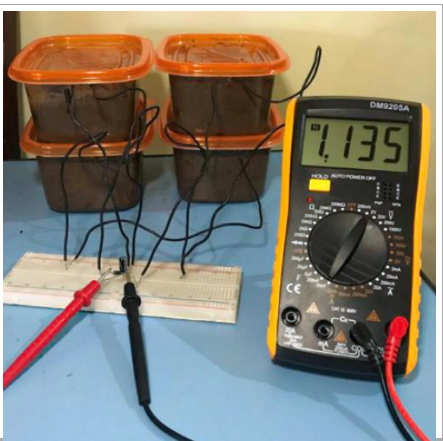This story is featured in the Asia Research News, March 10, 2023.
The natural activities of bacteria in soil mixed with chicken manure have been harnessed to generate electricity in a microbial fuel cell by researchers at Universiti Malaysia Sarawak (UNIMAS). Their work is published in the Pertanika Journal of Science & Technology. The innovation could become an inexpensive and simple source of electrical energy, especially in remote and less-developed areas, replacing more complex battery technologies.

“Our success is just part of our work at UNIMAS that is searching for methods to utilize natural resources for energy production,” says UNIMAS electronic engineer Siti Kudnie Sahari.

Connecting four of the units together is enough to power an LED light. UNIMAS scientists hope the system could soon provide electricity to remote areas.
The simple set-up used to demonstrate the system consists of a small plastic container with a cathode electrode sitting on top of the moist soil and chicken manure mixture and an anode electrode buried inside it. As bacteria process natural chemicals in the mixture, they generate electrons that are collected by the anode and transferred as an electric current through an external circuit to the cathode. Each unit consists of a pot small enough to be held in the palm of the hand.
Early prototypes successfully generated electricity, but their output was too low to power even small domestic appliances. The team eventually overcame this limitation by experimenting with different electrode materials, including metals and various forms of carbon. Copper and zinc electrodes worked reasonably well, but the best option found so far uses highly porous “activated carbon” as both the anode and cathode.
Connecting four of the units together generates sufficient electricity to power an energy-efficient LED light of the kind that is becoming increasingly common for domestic use. The team also designed and added a component called a DC-DC boost converter that can increase the voltage and power density further.
Other researchers have also explored soil-based microbial fuel cells, but the power density achieved by the UNIMAS team, at 904 milliwatts per square metre, is the highest that any research group has reported to date.
The team is now working to refine the system and tackle some remaining challenges, including irregular electron flow between the electrodes. At present, this prevents the system from maintaining a constant voltage. The researchers plan to develop a power management system that will enhance voltage levels and control to make the fuel cells suitable for powering domestic appliances.
“The initial achievement in lighting an LED demonstrates that our innovation could become commercially viable,” Sahari concludes, adding: “One of the most significant benefits of microbial fuel cells is their ability to generate electricity from waste, so providing a novel option to concurrently treat waste while receiving a source of clean and renewable energy.”
Prepared by Assoc Prof Ts Dr Siti Kudnie Sahari (Faculty of Engineering)